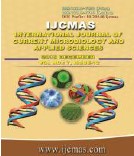


 National Academy of Agricultural Sciences (NAAS)
National Academy of Agricultural Sciences (NAAS)

|
PRINT ISSN : 2319-7692
Online ISSN : 2319-7706 Issues : 12 per year Publisher : Excellent Publishers Email : editorijcmas@gmail.com / submit@ijcmas.com Editor-in-chief: Dr.M.Prakash Index Copernicus ICV 2018: 95.39 NAAS RATING 2020: 5.38 |
An experiment consisting of three crop establishment methods in the main plots and five zinc fertilization in the sub-plots was undertaken in a split-plot design with three replications at Varanasi during Kharif season of 2016-17 and 2017-18. Data on N, P, K and Zn content (grain and straw) and their uptake were recorded. Crop establishment methods significantly influenced Zn content, and N, P, K and Zn uptake whereas Zn fertilization influenced significantly N, P, K and Zn content and their uptake. Results revealed that among crop establishment methods, conventional till-wet direct seeded rice estimated higher N, P, K and Zn content and their uptake. In the case of Zn fertilization, 6 kg Zn ha-1 (basal application) was proved superior over rest of the treatments for N, P and K content and their uptake. However, with respect to Zn content and its uptake, 6 kg Zn ha-1 (foliar application) was adjudged better as compared to other treatments. Based on the results, it is said in the conclusion that conventional till-wet direct seeded rice and 6 kg Zn ha-1 (basal application) was found better for N, P and K content and their uptake.
 |
 |
 |
 |
 |